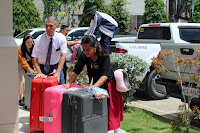Apartment for Rent
Today's post is pretty short, but it provides more detail about our primary focus, which is providing safe and secure housing for the young missionaries. We currently have 140 young missionaries living in 53 homes or apartments. We try to visit each apartment (I'll use the term apartment for the rest of this post, even though most missionaries live in standalone houses) once every six weeks, and we've mostly been successful with that cadence. As you've seen from previous posts, we fill the truck each morning with the supplies needed for each stop, although sometimes we leave more things than we planned to at an apartment in the morning, which shortchanges an apartment in the afternoon. We shop again at night (or early the next morning) to replenish our supplies and do it all over again the next day.
The spare bedroom is typically used as a dressing room and contains the dressers and clothes racks.
Here are two collages showing a nice apartment in Bayawan, which is home to four sister missionaries. This apartment is on the nicer end of a wide spectrum.
Notice the couch, which is not approved for missionary apartments unless the landlord provides one, the study desks (one for each missionary), the floor fans (one for each missionary), and the blue water jug (all missionaries, including us, must purchase purified drinking water for cooking, drinking, and brushing teeth).
In the collage below, notice the two mattresses on the floor, sandwiched between the two beds. This bedroom has a wall-mounted air conditioner, so the four missionaries prefer to cram into that bedroom rather than have two of them sleep in the other bedroom, which has no A/C.
(We replaced the twin beds with two bunkbeds, so there's no longer anyone sleeping on the floor. It also freed up a lot of floor space.)
The bathroom is first-class, since it has a shower, a sink, and a flush toilet (with a toilet seat!).
The gas stove and washing machine are both on the back porch, just off the kitchen. Washing machines have two tubs - one for washing the clothes and one for spinning them dry enough to hang on a clothesline. The wash tub is usually filled with a bucket of water because rarely is there a dedicated faucet, and the washing machine simply drains onto the tile floor and down the closest drain.
Here is a collage of a more basic apartment in Macasilao. Two elders live here, and it is up in the mountains in a rural area.
The kitchen has a bamboo floor, but otherwise it has all the comforts of home. The bathroom has a toilet that is flushed by pouring water down it (that's how most apartments are) using a "tabo" (a plastic pail with a handle, like a small cooking pot) and no toilet seat (that's also how most apartments are). There is no shower (that's also how most apartments are), so a missionary uses the tabo to pour water over himself from the large grey bucket in the bottom right of the bathroom photo, lathers up, and then rinses off using the tabo.
On our way to Macasilao we found (once again) that Google Maps doesn't always know the conditions of the roads that connect two points. (I use the term "roads" loosely, because we've driven down some very narrow, remote, and primitive paths.) Notice how the road we were traveling on abruptly ends. At least retracing our steps back to a different route didn't add too much time to this trip.
I hope this glimpse into missionary life in the Philippines was enjoyable!






Good job
ReplyDeleteWow! Talk about going the extra mile!
ReplyDeleteAre landlords responsible for housing bug control/abatement?
Landlords aren't very responsive in general. They don't have the resources to do much and most believe that the tenant is responsible for repairs and upkeep. It's all good, though!
DeleteI hope you're all well after the eruption of Mount Kanlaon which we saw on the news. Our prayers go with you all!
ReplyDelete